The global ransomware protection market is likely to reach from USD 31.5 billion in 2025 to approximately USD 136.7 billion by 2035, recording an absolute increase of USD 105.1 billion over the forecast period. This translates into a total growth of 333.6%, with the market forecast to expand at a compound annual growth rate (CAGR) of 15.8% between 2025 and 2035. The market size is expected to grow by nearly 4.3X during the same period, supported by the rising frequency and sophistication of ransomware attacks and increasing demand for comprehensive cybersecurity solutions across enterprises worldwide.
Quick Stats for Ransomware Protection Market
Between 2025 and 2030, the ransomware protection market is projected to expand from USD 31.5 billion to USD 63.4 billion, resulting in a value increase of USD 31.9 billion, which represents 30.3% of the total forecast growth for the decade. This phase of growth will be shaped by rising ransomware attack frequency targeting critical infrastructure, increasing regulatory compliance requirements for cybersecurity, and growing adoption of cloud-based security solutions. Organizations are expanding their cybersecurity investments to address the growing complexity of ransomware threats across hybrid IT environments.
From 2030 to 2035, the market is forecast to grow from USD 63.4 billion to USD 136.7 billion, adding another USD 73.2 billion, which constitutes 69.7% of the ten-year expansion. This period is expected to be characterized by widespread deployment of AI-powered threat detection systems, integration of zero-trust security architectures, and development of comprehensive ransomware recovery solutions. The growing focus on business continuity and cyber resilience will drive demand for more sophisticated ransomware protection platforms with advanced threat intelligence and automated response capabilities.
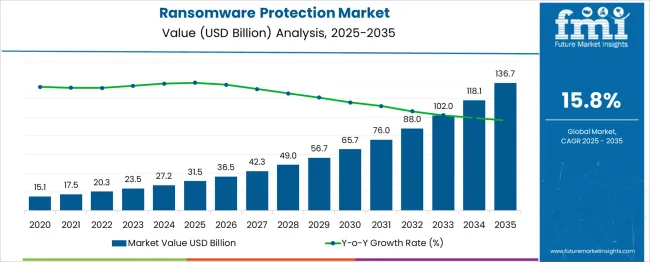
| Metric | Value |
| Estimated Value in (2025E) | USD 31.5 billion |
| Forecast Value in (2035F) | USD 136.7 billion |
| Forecast CAGR (2025 to 2035) | 15.8% |
Market expansion is being supported by the rapid increase in ransomware attack sophistication and the corresponding need for advanced protection solutions that can detect, prevent, and respond to evolving cyber threats. Modern enterprises rely on comprehensive ransomware protection systems to ensure business continuity, protect sensitive data, and maintain operational resilience against increasingly complex attack vectors. The growing digitization of business operations and increasing dependency on cloud infrastructure are driving demand for integrated security solutions from certified providers with appropriate threat intelligence capabilities and incident response expertise.
The expanding attack surface from remote work environments and rising cybercriminal monetization through ransomware-as-a-service models are creating significant demand for proactive security measures that can provide real-time threat detection and automated response capabilities. Government regulations mandating cybersecurity standards and data protection requirements are establishing new compliance frameworks that require comprehensive ransomware protection strategies and continuous security monitoring.
The market is segmented by component, deployment, organization size, application, end user, and region. By component, the market is divided into solutions and services. Solutions include standalone anti-ransomware software, secure web gateways, application control, IDS/IPS, threat intelligence, and web filtering. Services include professional services and managed services. Based on deployment, the market is categorized into on-premise, cloud, and hybrid. In terms of organization size, the market is segmented into large enterprises and small and medium-sized enterprises (SMEs). By application, the market includes endpoint protection, network protection, email protection, database protection, and web protection. End users comprise IT & telecom, BFSI, government & defense, healthcare & life sciences, education, retail/consumer goods, energy & utilities, media & entertainment, and others. Regionally, the market is divided into North America, Europe, East Asia, South Asia & Pacific, Latin America, and Middle East & Africa.

Solutions are projected to account for 66.9% of the ransomware protection market in 2025. This leading share is supported by the critical importance of ransomware protection software and technologies in defending against cyber threats. Solutions segment includes comprehensive security platforms, standalone anti-ransomware tools, and integrated security applications that provide real-time threat detection and prevention capabilities. The segment benefits from continuous technology advancement and increasing enterprise investment in proactive security measures.
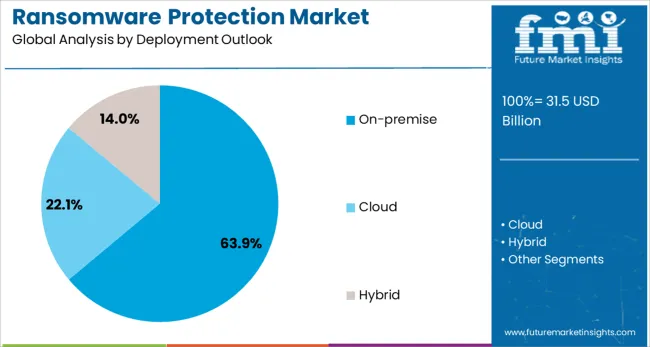
On-premise deployment is expected to represent 63.92% of the deployment segment in 2025. This dominant share reflects enterprise preference for maintaining direct control over security infrastructure and sensitive data protection systems. On-premise solutions provide enhanced security control, customization capabilities, and compliance with regulatory requirements for data sovereignty. The segment benefits from established IT infrastructure and comprehensive security management capabilities within enterprise environments.
Large enterprises are projected to contribute 70.8% of the organization size segment in 2025. This substantial share reflects the significant cybersecurity investment capacity and complex IT infrastructure requirements of large organizations. Large enterprises face sophisticated threat environments and require comprehensive security solutions that can protect diverse IT assets and business operations. The segment is supported by dedicated cybersecurity budgets and regulatory compliance requirements that mandate robust ransomware protection measures.
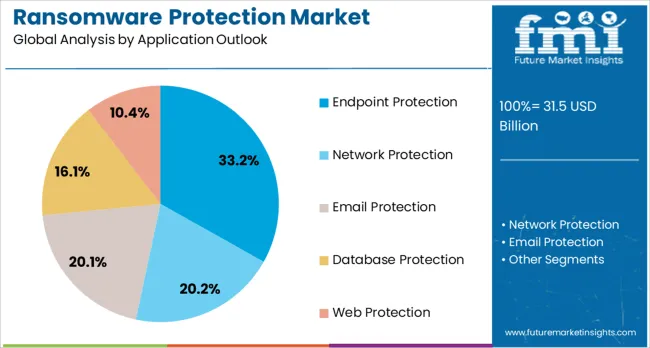
Endpoint protection is estimated to hold 33.15% of the application segment share in 2025. This significant share reflects the critical importance of securing end-user devices and workstations that serve as primary attack vectors for ransomware threats. Endpoint protection solutions provide real-time monitoring, threat detection, and automated response capabilities for diverse device types and operating environments. The segment benefits from increasing remote work trends and expanding attack surfaces requiring comprehensive endpoint security coverage.
IT & telecom sector is projected to represent 24.5% of the end user segment in 2025. This leading share reflects the high-value targets that technology companies represent for cybercriminals and the critical importance of protecting digital infrastructure and customer data. IT & telecom organizations require sophisticated ransomware protection that can defend complex network architectures and ensure service continuity. The segment demonstrates early adoption of advanced security technologies and comprehensive threat response capabilities.
The ransomware protection market is advancing rapidly due to increasing cyber threat sophistication and growing recognition of ransomware risks to business operations. The market faces challenges including cybersecurity skills shortage, complex threat landscape evolution, and varying security budget allocations across organizations. Technology advancement and threat intelligence sharing continue to influence market development and solution effectiveness.
The growing deployment of artificial intelligence and machine learning technologies is enabling advanced threat detection capabilities that can identify ransomware variants and attack patterns in real-time. AI-powered security systems provide automated response mechanisms and predictive threat analytics that enhance protection effectiveness while reducing response times. These advanced technologies are particularly valuable for detecting zero-day ransomware attacks and sophisticated evasion techniques that traditional security measures may miss.
Modern ransomware protection providers are incorporating zero-trust security principles that assume no implicit trust and continuously validate security permissions and access controls. Integration of identity verification, network segmentation, and continuous monitoring enables comprehensive protection strategies that limit attack propagation and minimize potential damage. Zero-trust architectures also support secure remote access and cloud security integration essential for modern hybrid work environments.
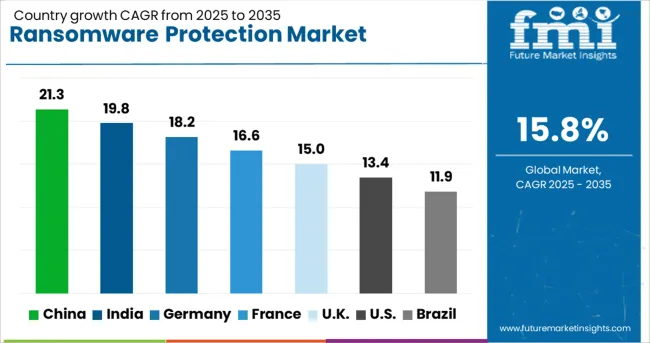
| Country | CAGR (2025-2035) |
| China | 21.3% |
| India | 19.8% |
| Germany | 18.2% |
| France | 16.6% |
| United Kingdom | 15.0% |
| United States | 13.4% |
| Brazil | 11.9% |
The ransomware protection market demonstrates exceptional growth across major economies, with China leading at a 21.3% CAGR through 2035, driven by rapid digitization and increasing cybersecurity investment. India follows at 19.8%, supported by expanding IT sector and growing cyber threat awareness. Germany records 18.2% growth, focusing on industrial cybersecurity and regulatory compliance. France shows 16.6% expansion, driven by national cybersecurity strategies and enterprise security investment. The United Kingdom demonstrates 15.0% growth, focusing on financial services security and data protection. The United States records 13.4% growth, supported by established cybersecurity infrastructure, while Brazil grows at 11.9% with developing cyber resilience capabilities.
The report covers an in-depth analysis of 40+ countries; seven top-performing countries are highlighted below.
Revenue from ransomware protection in China is projected to exhibit the highest growth rate with a CAGR of 21.3% through 2035, driven by comprehensive digitization initiatives and increasing government focus on cybersecurity resilience. The country's expanding digital economy and growing awareness of ransomware threats are creating significant demand for advanced protection solutions. Major technology companies and enterprises are establishing comprehensive cybersecurity programs to support the growing requirements of digital infrastructure and business operations.
Government cybersecurity policies are mandating improvement of national cyber resilience capabilities and establishing supportive frameworks for security technology adoption, driving investment in ransomware protection systems throughout major industrial and financial sectors. Digital infrastructure development programs are supporting deployment of advanced security technologies and threat intelligence capabilities that enhance protection effectiveness across critical business systems.
Revenue from ransomware protection in India is expanding at a CAGR of 19.8%, supported by rapid IT sector growth and increasing awareness of cybersecurity threats across enterprises and government organizations. The country's expanding digital infrastructure and growing cyber threat exposure are driving demand for comprehensive ransomware protection solutions that can defend diverse IT environments. Technology companies and enterprises are gradually establishing advanced cybersecurity capabilities to serve the growing requirements of digital business operations.
IT sector development and digital transformation initiatives are creating opportunities for ransomware protection suppliers that can provide scalable security solutions and technical expertise. Professional cybersecurity development and certification programs are building technical expertise among security professionals, enabling comprehensive ransomware protection deployment that meets international security standards and business requirements.
Demand for ransomware protection in Germany is projected to grow at a CAGR of 18.2%, supported by the country's focus on industrial cybersecurity and comprehensive data protection regulatory frameworks. German enterprises are implementing advanced ransomware protection systems that meet stringent security standards and regulatory compliance requirements. The market is characterized by focus on industrial security, critical infrastructure protection, and comprehensive risk management approaches.
Industrial sector investments are prioritizing cybersecurity technologies that can protect manufacturing systems and critical infrastructure while meeting German regulatory standards. Professional cybersecurity certification programs are ensuring comprehensive technical expertise among security professionals, enabling specialized ransomware protection deployment that supports diverse industrial applications and export requirements.
Demand for ransomware protection in France is expanding at a CAGR of 16.6%, driven by national cybersecurity strategy implementation and increasing enterprise security investment across major business sectors. French organizations are incorporating advanced ransomware protection technologies that support digital sovereignty objectives and comprehensive threat defense capabilities. The market benefits from government cybersecurity initiatives and established enterprise security modernization programs.
National cybersecurity development programs are facilitating adoption of advanced protection systems that provide enhanced threat detection and response capabilities while supporting French technology independence objectives. Professional security development initiatives are ensuring comprehensive capabilities among cybersecurity professionals, enabling specialized ransomware protection deployment that meets evolving threat environments and regulatory requirements.
Demand for ransomware protection in the United Kingdom is projected to grow at a CAGR of 15.0%, supported by comprehensive financial services security requirements and established data protection frameworks. British organizations are implementing ransomware protection systems that meet regulatory compliance standards and operational resilience requirements. The market is characterized by focus on financial sector security, data protection compliance, and comprehensive business continuity planning.
Financial services sector investments are enabling deployment of advanced ransomware protection systems that demonstrate superior threat defense capabilities while maintaining regulatory compliance standards. Professional regulatory development programs are ensuring specialized expertise among cybersecurity professionals, enabling comprehensive protection deployment that meets evolving financial sector requirements and international standards.
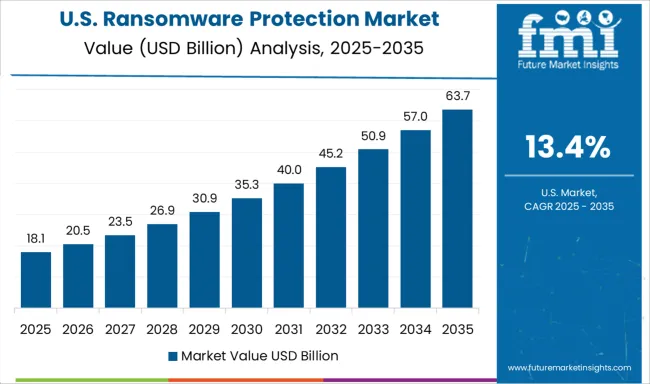
Demand for ransomware protection in the United States is expanding at a CAGR of 13.4%, driven by established cybersecurity infrastructure and continued advancement in threat defense technologies. American organizations are maintaining comprehensive ransomware protection capabilities through adoption of advanced security platforms and threat intelligence systems. The market benefits from substantial private sector investment and comprehensive government cybersecurity initiatives.
Cybersecurity technology investments are enabling continued advancement of ransomware protection capabilities through integration of innovative threat detection and response technologies. Professional cybersecurity development programs are maintaining technical expertise among security professionals, enabling comprehensive protection capabilities that support diverse enterprise requirements and critical infrastructure protection.
Revenue from ransomware protection in Brazil is growing at a CAGR of 11.9%, driven by developing cyber resilience capabilities and increasing awareness of ransomware threats across enterprises and government organizations. Brazilian organizations are investing in ransomware protection technologies that can address evolving cyber threats and improve business continuity capabilities. Cybersecurity providers and enterprises are establishing protection programs to serve growing security requirements.
Cyber resilience development programs are facilitating adoption of ransomware protection technologies that support comprehensive threat defense across diverse business environments. Professional cybersecurity capability development initiatives are enhancing technical expertise among security professionals, enabling ransomware protection deployment that meets evolving threat environments and business continuity requirements.

The ransomware protection market in Europe is projected to grow substantially across major countries, with Germany leading the regional market development. The United Kingdom maintains strong demand for ransomware protection solutions, supported by comprehensive cybersecurity frameworks and established financial services security requirements. France demonstrates consistent investment in cybersecurity technologies, driven by government digital sovereignty initiatives and enterprise security modernization programs.
Germany is expected to maintain its leadership position in European ransomware protection adoption, supported by its advanced manufacturing sector cybersecurity needs and comprehensive data protection regulations. The country benefits from established cybersecurity industry capabilities and supportive regulatory environment for security technology advancement.
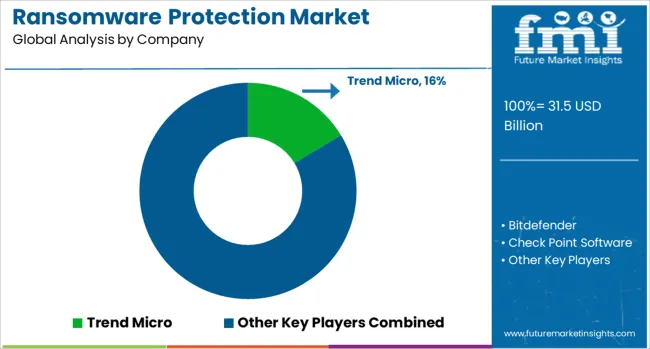
The ransomware protection market is defined by competition among cybersecurity companies, technology platforms, and managed security service providers. Companies are investing in advanced threat detection technologies, artificial intelligence systems, comprehensive threat intelligence platforms, and incident response capabilities to deliver effective, scalable, and cost-efficient ransomware protection solutions. Strategic partnerships, technology innovation, and market expansion strategies are central to strengthening product portfolios and customer relationships.
Trend Micro, Japan-based, offers comprehensive ransomware protection platforms with focus on endpoint security and threat intelligence capabilities. Bitdefender, Romania, provides advanced threat detection solutions with focus on AI-powered security technologies. Check Point Software Technologies, Israel, delivers integrated security platforms with focus on network protection and threat prevention. Cisco, United States, focuses comprehensive security architectures and enterprise protection solutions. CrowdStrike Holdings, Inc, United States, focuses on cloud-native endpoint protection and threat hunting capabilities. ESET, Slovakia, provides comprehensive security solutions with focus on malware detection and system protection. Trellix, United States, offers advanced threat defense platforms and security analytics capabilities. Fortinet, Inc, United States, delivers integrated security fabrics and network protection solutions. Kaspersky Lab, Russia, provides comprehensive cybersecurity platforms and threat research capabilities. Malwarebytes, United States, McAfee, United States, Microsoft, United States, Palo Alto Networks, Inc, United States, and SentinelOne, United States, offer specialized ransomware protection expertise, advanced threat detection capabilities, and comprehensive security solutions across global enterprise and government markets.
| Item | Value |
|---|---|
| Quantitative Units | USD 136.7 billion |
| Component | Solutions (standalone anti-ransomware software, secure web gateways, application control, IDS/IPS, threat intelligence, web filtering), services (professional services, managed services) |
| Deployment | On-premise, cloud, hybrid |
| Organization Size | Large enterprises, small and medium-sized enterprises (SMEs) |
| Application | Endpoint protection, network protection, email protection, database protection, web protection |
| End User | IT & telecom, BFSI, government & defense, healthcare & life sciences, education, retail/consumer goods, energy & utilities, media & entertainment, others |
| Regions Covered | North America, Europe, East Asia, South Asia & Pacific, Latin America, Middle East & Africa |
| Country Covered | United States, Canada, United Kingdom, Germany, France, China, Japan, South Korea, India, Brazil, Australia and 40+ countries |
| Key Companies Profiled | Trend Micro, Bitdefender, Check Point Software Technologies, Cisco, CrowdStrike Holdings Inc, ESET, Trellix, Fortinet Inc, Kaspersky Lab, Malwarebytes, McAfee, Microsoft, Palo Alto Networks Inc, SentinelOne |
| Additional Attributes | Dollar sales by component, deployment, organization size, application, and end user, regional demand trends across North America, Europe, and Asia-Pacific, competitive landscape with established cybersecurity companies and emerging threat detection providers, development capabilities for different threat environments and organizational requirements, integration with advanced AI technologies and zero-trust security architectures, innovations in automated threat response and behavioral analytics systems, and adoption of comprehensive threat intelligence platforms with real-time monitoring and incident response optimization for enhanced cyber resilience and business continuity. |
Component Outlook:
Solutions:
Services:
Deployment Outlook:
Organization Size Outlook:
Application Outlook:
End User Outlook:
Region:
The global ransomware protection market is estimated to be valued at USD 31.5 billion in 2025.
The market size for the ransomware protection market is projected to reach USD 136.7 billion by 2035.
The ransomware protection market is expected to grow at a 15.8% CAGR between 2025 and 2035.
The key product types in ransomware protection market are solutions, _standalone anti‑ransomware software, _secure web gateways, _application control, _ids/ips, _threat intelligence, _web filtering, services, _professional services and _managed services.
In terms of deployment outlook, on-premise segment to command 63.9% share in the ransomware protection market in 2025.
Explore Similar Insights

Thank you!
You will receive an email from our Business Development Manager. Please be sure to check your SPAM/JUNK folder too.
Chat With
MaRIA